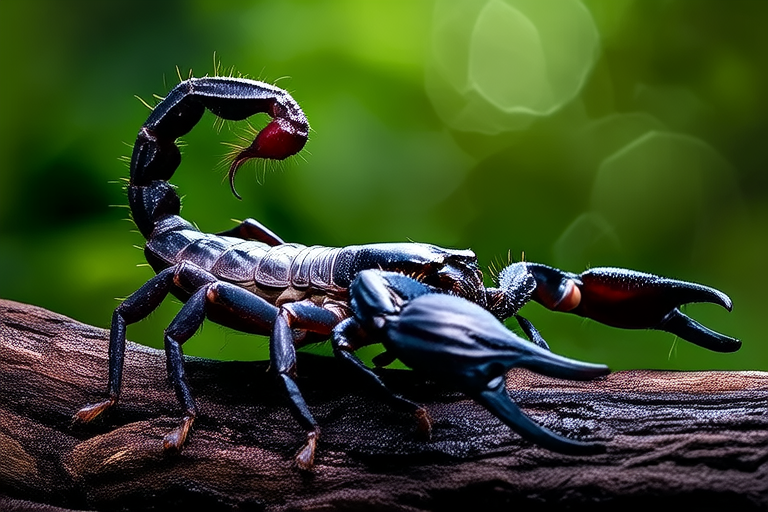From Jungle to Home: How to Care for Your Exotic Scorpion, Heterometrus Spinifer
The Heterometrus Spinifer, commonly known as the Asian forest scorpion, is a fascinating and captivating arachnid that originates from the dense jungles of Southeast Asia. This species is not only visually striking but also has unique behaviors and needs that make it an intriguing addition to any exotic pet enthusiast’s collection.
Unique Characteristics of Heterometrus Spinifer
The Heterometrus Spinifer is characterized by its robust body structure and impressive size, reaching lengths of up to 7 inches. It boasts a distinctively long tail, or telson, which houses the venomous stinger. The scorpion’s coloration typically ranges from dark brown to black, providing excellent camouflage in its natural habitat. What sets this species apart is its ability to adapt to various environments within its native range, making it a versatile and resilient creature.
Natural Habitat and Behavior in the Wild
In the wild, the Heterometrus Spinifer thrives in the humid and densely vegetated forests of countries such as Thailand, Malaysia, and Indonesia. These scorpions prefer areas with high humidity levels, dense undergrowth, and plenty of hiding spots. They are primarily nocturnal, spending their days concealed in crevices or beneath leaf litter and emerging at night to hunt for prey. Their diet consists mainly of insects, though they have been known to consume small vertebrates on occasion. Understanding these natural behaviors is crucial for replicating their environment in captivity.
Setting Up the Appropriate Enclosure
Enclosure Size and Shape
When setting up an enclosure for your Heterometrus Spinifer, it is important to provide ample space for movement and exploration. A terrarium measuring at least 18 inches in length, 12 inches in width, and 12 inches in height will suffice for a single adult scorpion. Ensure that the enclosure has secure ventilation to maintain proper air circulation without allowing escape.
Substrate
The substrate should be deep enough to allow burrowing, approximately 4-6 inches in depth. Opt for a mix of organic materials such as coconut fiber, peat moss, and bark chips to mimic the scorpion’s natural environment. This substrate should retain moisture well, contributing to the maintenance of the required humidity levels.
Temperature and Humidity
Maintaining the correct temperature and humidity levels is essential for the health and wellbeing of your scorpion. The ideal temperature range for the Heterometrus Spinifer is between 75°F and 85°F (24°C to 29°C). Use a digital thermometer to monitor these conditions accurately. The humidity should be kept between 70% and 80%. Utilize a hygrometer to measure humidity levels and adjust accordingly. Mist the enclosure daily to maintain the desired humidity.
Lighting Requirements
As nocturnal creatures, Heterometrus Spinifers do not require direct exposure to light. However, providing a day-night cycle can help regulate their circadian rhythms. Install a low-wattage red or blue bulb outside the enclosure to simulate nighttime conditions, ensuring it does not produce excessive heat. Avoid placing the enclosure near windows or other sources of direct sunlight.
Diet and Feeding Habits
The Heterometrus Spinifer is an opportunistic feeder, consuming a variety of insects and occasionally small vertebrates. In captivity, offer a diet consisting of crickets, mealworms, and dubia roaches. Feed juveniles every 2-3 days, while adults can be fed once a week. Ensure that the prey items are appropriately sized; too large and they may pose a choking hazard, too small and they won’t provide adequate nutrition. Remove uneaten prey after 24 hours to prevent contamination.
Handling and Safety Precautions
Despite their intimidating appearance, Heterometrus Spinifers are generally docile and unlikely to sting unless provoked. However, handling should always be approached with caution. Wear thick gloves to protect against potential stings. Always handle the scorpion gently, avoiding sudden movements that could startle it. Never attempt to grab the scorpion by its tail or pinchers. Instead, use a soft brush or tongs to guide it into a container for transport.
Maintaining Hygiene and Health Checks
Regular cleaning of the enclosure is vital to prevent bacterial growth and maintain optimal living conditions. Spot clean daily, removing waste and uneaten food. Perform a thorough cleaning every two weeks, replacing the substrate and sterilizing all accessories. During routine health checks, observe your scorpion’s behavior, appetite, and overall appearance. Look out for signs of distress, such as lethargy, loss of appetite, or unusual behavior. If you notice any concerning symptoms, consult a veterinarian specializing in exotic pets.
Tips for Enrichment and Environmental Stimulation
To ensure a fulfilling life for your Heterometrus Spinifer, incorporate elements that stimulate its natural instincts. Provide a variety of hiding spots using cork bark, rocks, and artificial plants. Introduce climbing structures like branches or vines to encourage exploration. Rotate these items periodically to keep the environment interesting. Additionally, consider enriching the enclosure with scent-based stimuli, such as adding fresh herbs or aromatic wood shavings. These additions will help replicate the sensory experiences found in the wild, enhancing the quality of life for your pet.
In conclusion, caring for a Heterometrus Spinifer requires dedication and attention to detail. By understanding its unique characteristics, replicating its natural habitat, and providing proper care, you can ensure that your scorpion leads a healthy and happy life. Remember, the responsibility of owning an exotic pet comes with a commitment to their well-being, so approach this endeavor with respect and enthusiasm.
